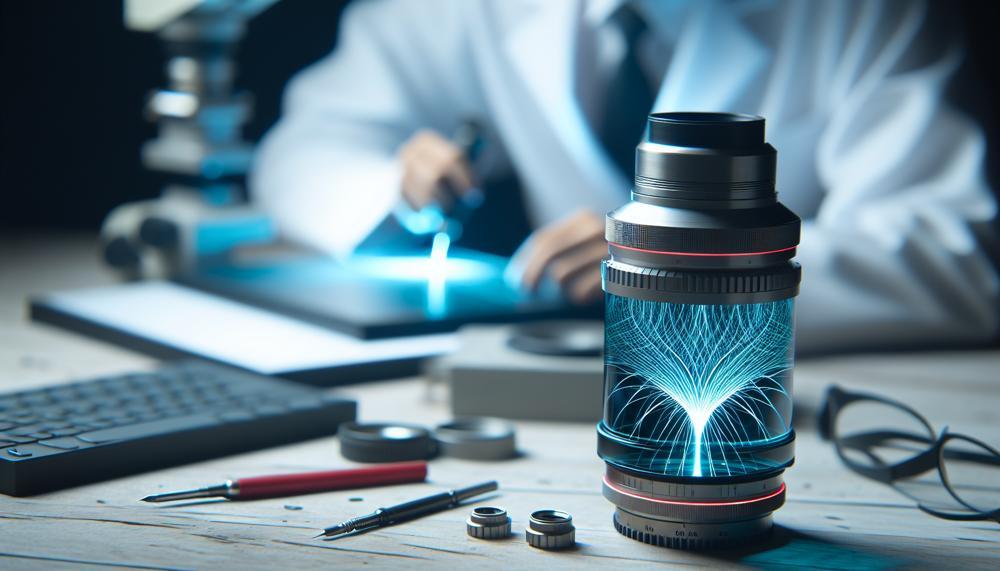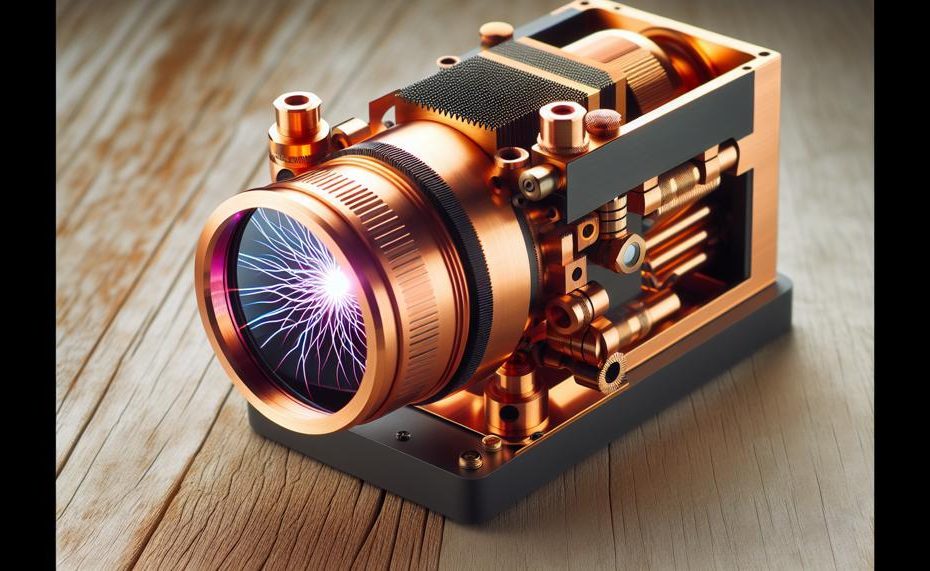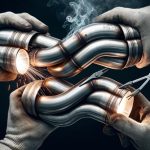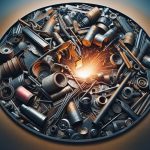Welcome to the illuminating world of plasma cutting, a realm where precision meets power to slice through materials with ease. But as we dive into this high-energy process, one crucial aspect often overlooked is the choice of lens shade for your safety gear. Why, you may ask, does this detail matter so much? Well, you’re in for an enlightening discussion.
In this blog post, we’re going to shed light on the pivotal role of lens shades in plasma cutting, ensuring you’re well-equipped to make informed decisions for both your safety and the quality of your work.
So, what shade lens is required for plasma cutting?
The shade of lens required for plasma cutting depends on the arc current. For less intense currents, a lighter shade like 4 or 5 may be sufficient. For currents of 300 Amperes or higher, you may need shades 12 to 14. Most people find that a #10 shade or higher is sufficient for protecting their eyes during plasma cutting. If the light from the machine is too intense even with a #10 shade lens, then it may be necessary to go up to a #11 or even #12 shade lens for optimal protection.
As a rule of thumb, start with a shade that is too dark to see the weld zone, then go to a lighter shade that gives a sufficient view of the weld zone without going below the minimum.
So, let’s get started.
Contents
What is Plasma Cutting?
Plasma cutting, a marvel in the world of metal fabrication, harnesses a high-velocity jet of ionized gas at temperatures soaring up to 30,000 degrees Fahrenheit.
This gas, or plasma, conducts electricity, slicing through materials with precision and speed.
How Plasma Cutting Operates:
Plasma cutting functions by channeling a gas through a narrow opening. In this passage, an electric arc is generated from an external power supply, transforming the gas into plasma.
This intensely hot plasma jet then melts the metal upon contact, while a high-speed gas flow ejects the molten material, creating a clean cut.
The Importance of the Correct Shade Lens:
Using the correct shade lens is paramount for safeguarding one’s eyes from the brilliant light emitted during plasma cutting. The intense brightness, rich in harmful ultraviolet (UV) and infrared (IR) radiation, poses a risk of flash burns or long-term vision impairment.
The correct shade lens mitigates these risks, absorbing or deflecting the harmful rays, ensuring the operator’s safety.
Selecting the Right Shade Lens:
The choice of the appropriate shade lens depends on the plasma cutter’s amperage and the material’s thickness. Here’s a guide to help select the right protection:
| Amperage Range | Recommended Shade | Notes |
| Under 40 amps | #6 | Suitable for low amperage cutting |
| 40-100 amps | #8-#9 | Standard range for moderate cutting tasks |
| 100 amps and above | #10-#13 | For high amperage, intense cutting operations |
Choosing a lens that doesn’t correspond to the operation’s demands can lead to discomfort, eye strain, or serious eye damage. Thus, matching the lens shade to the cutting task is not just a safety measure but a necessity for maintaining visual health.
Types of Plasma Cutters
Plasma cutters are critical tools for cutting through various materials with precision and speed. The type of plasma cutter you choose should align with your work requirements and safety standards, particularly when it comes to eye protection.
Here’s a succinct guide on different types of plasma cutters and the corresponding required shade lenses for each.
Handheld Manual Plasma Cutters
These are the most common types, favored for their portability and ease of use in both professional and hobbyist settings.
They’re suitable for cutting smaller plate sizes and are perfect for quick, on-the-go tasks.
| Type | Amp Range | Required Shade Lens |
| Low Amperage Handheld | Up to 40 Amps | Shade #6-8 |
| High Amperage Handheld | 40-100 Amps | Shade #8-9 |
Automated CNC Plasma Cutters
These cutters are designed for industrial applications, offering high precision and productivity.
They can handle larger plate sizes and thicknesses, ideal for repetitive and detailed cutting tasks.
| Type | Amp Range | Required Shade Lens |
| Low Amperage CNC | Up to 60 Amps | Shade #8 |
| High Amperage CNC | 60-200 Amps | Shade #10-12 |
Specialty Plasma Cutters
These include models designed for specific applications, such as underwater cutting or with enhanced safety features.
The required shade lens can vary greatly depending on the cutter’s features and the environment in which it is used.
| Type | Application | Required Shade Lens |
| Underwater Plasma Cutter | Underwater cutting | Shade #12-14 |
| Precision Plasma Cutter | High-precision cutting | Shade #10-13 |
Choosing the correct shade lens for the plasma cutter you’re using is not just about following rules; it’s about safeguarding your sight.
Whether you’re slicing through thin sheets or tackling thicker materials, always ensure your eyes are well-protected with the appropriate shaded lens to prevent strain and injuries.
Understanding the Light Intensity Generated by Plasma Cutting
When tackling the bright spark of plasma cutting, the intensity of light generated is a crucial factor in selecting the proper shade lens for your welding helmet. This radiant light, if not properly shielded, can lead to a condition known as “arc eye,” a painful reminder of the power at play.
The choice of lens shade directly influences how well a welder’s eyes are protected from the harsh glare and ultraviolet (UV) and infrared (IR) radiation emitted during the cutting process.
Key Considerations for Lens Shade Selection
- Amperage of the Plasma Cutter: The higher the amperage, the brighter the light, necessitating a darker shade to effectively filter out harmful rays.
- Material Thickness: Cutting thicker materials requires higher amperage, which in turn requires lenses with a higher shade number to protect against the intensified light.
- Type of Electrode Used: Different electrodes can alter the intensity of the plasma arc, affecting the choice of protective lens shade.
Choosing the Right Shade Lens
The selection of the appropriate shade lens is not a one-size-fits-all scenario. It hinges on balancing protection with visibility. Too dark a lens, and you’re cutting blind, guessing where the material starts and ends; too light, and you risk your sight.
The table below offers a guideline for selecting a lens shade based on plasma cutter amperage:
| Amperage | Recommended Shade Number | Material Thickness |
| 0-40 Amps | #6-8 | Thin materials |
| 40-100 Amps | #8-10 | Medium materials |
| 100 Amps and above | #10-12 | Thick materials |
Remember, the aim is to shield your eyes whilst maintaining a clear line of sight on your work. Advanced helmets with auto-darkening lenses can adjust the shade dynamically, based on the intensity of the light produced, offering both protection and visibility. Comfort, durability, and the lens’s ability to swiftly transition between shades are also vital features to consider.
Safeguarding Your Vision
Above all, prioritizing safety can’t be overstressed. The intense light from plasma cutting doesn’t just pose a risk to your eyes but can also affect your skin.
Wearing a full-face welding helmet with the correct shade lens, alongside other personal protective equipment (PPE), ensures you stay safe while mastering the art of plasma cutting.
Choosing the Right Shade Lens for Your Welding Helmet
When it comes to plasma cutting, picking the perfect shade lens for your welding helmet ain’t just about keeping your peepers safe—it’s about making sure you can see what you’re doing without getting a headache or, worse, damaging your eyes.
| Factor | Detail | Why It Matters |
| Amperage of Plasma Cutter | #6 for low; up to #12+ for high | Higher amperage = brighter spark. Match the lens shade to avoid dazzle. |
| Material Thickness | Thicker requires higher shade | Thick stuff means more spark. Protect your eyes with a higher shade. |
| Type of Electrode | Varies | Different strokes for different folks. Electrodes can change the light show. |
| OSHA Safety Standards | Must comply | No funny business here. Safety first means following the rules to the letter. |
| Distance from Cutting | Closer = Higher shade | Like staring at the sun, closer ain’t better. Up the shade if you’re in close. |
| Material Being Cut | Varies | Some materials are flashier than others. Know your material, know your shade. |
| Comfort and Fit | Adjustable, cushioned, light | A comfy helmet means less fidgeting, more cutting. Don’t skimp on the snug fit. |
| Durability | Sparks and debris resistant | You want a helmet that can take a beating and not crack under pressure. |
Let’s be honest, your welding helmet is your best mate on the job. It’s gotta be tough, it’s gotta be comfy, and it must keep your eyes safe from the dazzling light of plasma cutting.
By weighing up these factors—from the firepower of your plasma cutter to the thickness of the material, and not forgetting the crucial OSHA standards—you’re setting yourself up for success.
And remember, a helmet that feels like a part of you, with all the right adjustments and padding, will make the job a breeze.
Factors to Consider When Choosing a Welding Helmet for Plasma Cutting
When selecting a welding helmet for plasma cutting, particularly with a focus on the required shade lens, it’s essential to zero in on a few pivotal considerations. Here’s a succinct guide, including a handy table, to navigate through these considerations:
Key Factors for Choosing the Right Shade Lens:
- Amperage Level: The intensity of the plasma cutter plays a significant role. Higher amperage requires a darker shade to safeguard your eyes effectively.
- Material Being Cut: The thickness and type of material can influence the brightness of the plasma arc, thus affecting the shade requirement.
- Type of Electrode Used: Different electrodes can alter the arc’s intensity, thereby necessitating adjustments in the lens shade for optimal protection.
- Auto-Darkening Feature: Helmets with auto-darkening lenses adjust automatically to the appropriate shade, providing both convenience and protection.
- Comfort and Fit: Ensure the helmet is comfortable for long periods, as discomfort can lead to distractions and potential safety hazards.
- Durability: Look for helmets crafted from sturdy materials capable of withstanding the rigours of plasma cutting.
Here’s a simple table to break down the recommended shade levels based on amperage, as suggested by safety standards:
| Amperage Range | Recommended Shade Level | Material Thickness |
| 0-25 Amps | #6 Shade | Thin Metals |
| 26-50 Amps | #8 Shade | Medium Thickness Metals |
| 51-150 Amps | #10 Shade | Thick Metals |
| 150+ Amps | #12 or Higher | Very Thick Metals |

By adhering to these guidelines, you can ensure your eyes are shielded effectively during plasma cutting tasks. Remember, it’s not just about choosing any helmet; it’s about picking one that offers the right combination of protection, functionality, and comfort tailored to your specific cutting requirements.
Conclusion
When it comes to safety in the exciting world of plasma cutting, eye protection shines the brightest. As you go through this very precise and intense process, one important but often overlooked part becomes clear: the lens shade of your welding helmet. As we learn about plasma cutting, from how it works to choosing the right tools, we’ve come to realize how important it is to have the right shade lens for both safety and performance.
Choosing the right lens shade is more than just following safety rules; it’s a fine balance between keeping your vision safe and keeping the clarity you need to make exact cuts. The suggested color changes depending on the voltage and thickness of the material. This shows that the choice you make is not just a matter of taste but a very important one that affects your health and the quality of your work.
Now that you know more about plasma cutting and are about to start your next project, remember that the right shade of lens will help you reach success. It not only keeps you safe from the plasma arc’s bright show, but it also makes sure that every cut shows how skilled and accurate you are.





